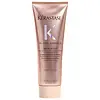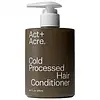What's inside
What's inside
 Key Ingredients
Key Ingredients

 Benefits
Benefits

 Concerns
Concerns

 Ingredients Side-by-side
Ingredients Side-by-side

Water
Skin ConditioningCetearyl Alcohol
EmollientCocamidopropyl Betaine
CleansingBehentrimonium Chloride
PreservativePropylene Glycol
HumectantAmodimethicone
Parfum
MaskingIsopropyl Alcohol
SolventSodium Chloride
MaskingPhenoxyethanol
PreservativeHydroxypropyl Guar
Emulsion StabilisingEthanolamine
BufferingPolyquaternium-37
Limonene
PerfumingCaprylyl Glycol
EmollientPropylene Glycol Dicaprylate/Dicaprate
EmollientCocos Nucifera Oil
MaskingTrideceth-6
EmulsifyingPPG-1 Trideceth-6
Skin ConditioningLinalool
PerfumingCitronellol
PerfumingCetrimonium Chloride
AntimicrobialAcrylates/Stearyl Methacrylate Copolymer
Emulsion StabilisingSorbitan Oleate
EmulsifyingSodium Hyaluronate
HumectantCaprylic/Capric Triglyceride
MaskingLactic Acid
BufferingHexyl Cinnamal
PerfumingAlpha-Isomethyl Ionone
PerfumingGlycolic Acid
BufferingCitric Acid
BufferingEDTA
Rosa Canina Flower Extract
AstringentWater, Cetearyl Alcohol, Cocamidopropyl Betaine, Behentrimonium Chloride, Propylene Glycol, Amodimethicone, Parfum, Isopropyl Alcohol, Sodium Chloride, Phenoxyethanol, Hydroxypropyl Guar, Ethanolamine, Polyquaternium-37, Limonene, Caprylyl Glycol, Propylene Glycol Dicaprylate/Dicaprate, Cocos Nucifera Oil, Trideceth-6, PPG-1 Trideceth-6, Linalool, Citronellol, Cetrimonium Chloride, Acrylates/Stearyl Methacrylate Copolymer, Sorbitan Oleate, Sodium Hyaluronate, Caprylic/Capric Triglyceride, Lactic Acid, Hexyl Cinnamal, Alpha-Isomethyl Ionone, Glycolic Acid, Citric Acid, EDTA, Rosa Canina Flower Extract
Water
Skin ConditioningGlycerin
HumectantEthylhexyl Olivate
Skin ConditioningIsostearyl Ethylimidazolinium Ethosulfate
Triethyl Citrate
MaskingAcrylamidopropyltrimonium Chloride/Acrylates Copolymer
Palmitamidopropyltrimonium Chloride
Hydroxypropyl Starch Phosphate
Cetrimonium Chloride
AntimicrobialIsoceteth-20
EmulsifyingIsohexadecane
EmollientMagnesium Aluminum Silicate
AbsorbentSorbitan Oleate
EmulsifyingIsoamyl Laurate
EmollientPropylene Glycol Dibenzoate
Skin ConditioningAdansonia Digitata Seed Oil
EmollientAmaranthus Caudatus Seed Oil
EmollientAmyris Balsamifera Bark Oil
MaskingAquilaria Agallocha Wood Oil
MaskingCananga Odorata Flower Oil
MaskingCaprylic/Capric Triglyceride
MaskingCaprylyl Glycol
EmollientCistus Ladaniferus Leaf/Stem Extract
MaskingCitric Acid
BufferingCoceth-7
EmulsifyingCrambe Abyssinica Seed Oil
Skin ConditioningDimethylheptenal
PerfumingElettaria Cardamomum Seed Oil
MaskingGamma-Nonalactone
MaskingGuar Hydroxypropyltrimonium Chloride
Skin ConditioningHelianthus Annuus Seed Oil
EmollientHexenyl Acetate
MaskingHexylene Glycol
EmulsifyingHydrogenated Castor Oil/Sebacic Acid Copolymer
EmollientHydrolyzed Pea Protein
EmollientHydrolyzed Quinoa
Skin ConditioningHydrolyzed Soy Protein
HumectantIonone
AstringentJuniperus Virginiana Oil
MaskingLavandula Angustifolia Oil
MaskingLinoleic Acid
CleansingLinolenic Acid
CleansingMoringa Oleifera Seed Oil
EmollientPanthenol
Skin ConditioningPassiflora Edulis Seed Oil
EmollientPhenoxyethanol
PreservativePogostemon Cablin Leaf Oil
MaskingPotassium Sorbate
PreservativeRosmarinus Officinalis Leaf Extract
AntimicrobialSodium Hydroxide
BufferingSqualane
EmollientTetrasodium Glutamate Diacetate
Vanillin
MaskingViola Odorata Flower/Leaf Extract
MaskingWater, Glycerin, Ethylhexyl Olivate, Isostearyl Ethylimidazolinium Ethosulfate, Triethyl Citrate, Acrylamidopropyltrimonium Chloride/Acrylates Copolymer, Palmitamidopropyltrimonium Chloride, Hydroxypropyl Starch Phosphate, Cetrimonium Chloride, Isoceteth-20, Isohexadecane, Magnesium Aluminum Silicate, Sorbitan Oleate, Isoamyl Laurate, Propylene Glycol Dibenzoate, Adansonia Digitata Seed Oil, Amaranthus Caudatus Seed Oil, Amyris Balsamifera Bark Oil, Aquilaria Agallocha Wood Oil, Cananga Odorata Flower Oil, Caprylic/Capric Triglyceride, Caprylyl Glycol, Cistus Ladaniferus Leaf/Stem Extract, Citric Acid, Coceth-7, Crambe Abyssinica Seed Oil, Dimethylheptenal, Elettaria Cardamomum Seed Oil, Gamma-Nonalactone, Guar Hydroxypropyltrimonium Chloride, Helianthus Annuus Seed Oil, Hexenyl Acetate, Hexylene Glycol, Hydrogenated Castor Oil/Sebacic Acid Copolymer, Hydrolyzed Pea Protein, Hydrolyzed Quinoa, Hydrolyzed Soy Protein, Ionone, Juniperus Virginiana Oil, Lavandula Angustifolia Oil, Linoleic Acid, Linolenic Acid, Moringa Oleifera Seed Oil, Panthenol, Passiflora Edulis Seed Oil, Phenoxyethanol, Pogostemon Cablin Leaf Oil, Potassium Sorbate, Rosmarinus Officinalis Leaf Extract, Sodium Hydroxide, Squalane, Tetrasodium Glutamate Diacetate, Vanillin, Viola Odorata Flower/Leaf Extract
 Reviews
Reviews

Alternatives
Ingredients Explained
These ingredients are found in both products.
Ingredients higher up in an ingredient list are typically present in a larger amount.
This ingredient is an emollient, solvent, and texture enhancer. It is considered a skin-softener by helping the skin prevent moisture loss.
It helps thicken a product's formula and makes it easier to spread by dissolving clumping compounds.
Caprylic Triglyceride is made by combining glycerin with coconut oil, forming a clear liquid.
While there is an assumption Caprylic Triglyceride can clog pores due to it being derived from coconut oil, there is no research supporting this.
Learn more about Caprylic/Capric TriglycerideCaprylyl Glycol is a humectant and emollient, meaning it attracts and preserves moisture.
It is a common ingredient in many products, especially those designed to hydrate skin. The primary benefits are retaining moisture, skin softening, and promoting a healthy skin barrier.
Though Caprylyl Glycol is an alcohol derived from fatty acids, it is not the kind that can dry out skin.
This ingredient is also used as a preservative to extend the life of products. It has slight antimicrobial properties.
Learn more about Caprylyl GlycolThis ingredient is a preservative, antimicrobial, and emulsifier. It is often used in cosmetics for its ability to cleanse, condition, and reduce static.
Cetrimonium chloride is a quaternary ammonium salt, meaning it has a water-soluble structure.
Citric Acid is an alpha hydroxy acid (AHA) naturally found in citrus fruits like oranges, lemons, and limes.
Like other AHAs, citric acid can exfoliate skin by breaking down the bonds that hold dead skin cells together. This helps reveal smoother and brighter skin underneath.
However, this exfoliating effect only happens at high concentrations (20%) which can be hard to find in cosmetic products.
Due to this, citric acid is usually included in small amounts as a pH adjuster. This helps keep products slightly more acidic and compatible with skin's natural pH.
In skincare formulas, citric acid can:
While it can provide some skin benefits, research shows lactic acid and glycolic acid are generally more effective and less irritating exfoliants.
Most citric acid used in skincare today is made by fermenting sugars (usually from molasses). This synthetic version is identical to the natural citrus form but easier to stabilize and use in formulations.
Read more about some other popular AHA's here:
Learn more about Citric AcidPhenoxyethanol is a preservative that has germicide, antimicrobial, and aromatic properties. Studies show that phenoxyethanol can prevent microbial growth. By itself, it has a scent that is similar to that of a rose.
It's often used in formulations along with Caprylyl Glycol to preserve the shelf life of products.
Sorbitan Oleate is created from compounds in oleic acid and sorbitol.
It is used to stabilize a product by preventing ingredients from separating. Emulsifiers help keep ingredients together, such as oils and water.
According to a manufacturer, the ingredient Sorbitan Monooleate shares an INCI name with this one.
Sorbitan Oleate may not be fungal acne safe. It can also worsen oily skin.
Learn more about Sorbitan OleateWater. It's the most common cosmetic ingredient of all. You'll usually see it at the top of ingredient lists, meaning that it makes up the largest part of the product.
So why is it so popular? Water most often acts as a solvent - this means that it helps dissolve other ingredients into the formulation.
You'll also recognize water as that liquid we all need to stay alive. If you see this, drink a glass of water. Stay hydrated!
Learn more about Water